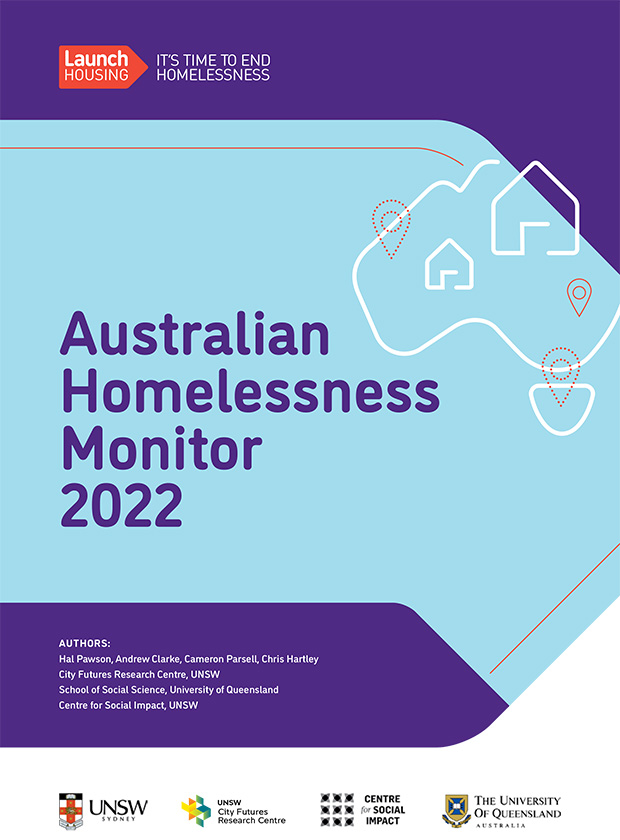National Homelessness Monitor 2022
December 5 2022
Homelessness in Australia becomes more widespread according to national monitor
Rising homelessness continues to outpace Australia’s growing population, according to Launch Housing’s Australian Homelessness Monitor released today.
The study found the average monthly number of people using homelessness services increased by 8 per cent in the four years to 2021-22, double the national population increase over that period.
The Monitor, commissioned by Launch Housing and produced by University of New South Wales (City Futures Research Centre) and University of Queensland, is the first major homelessness analysis spanning the COVID-19 crisis years.
The sudden reductions in street homelessness achieved through 2020 COVID-19 emergency accommodation programs in cities such as Melbourne, Sydney and Brisbane provided only temporary respite to the problem.
The Monitor has revealed that despite these efforts, homelessness continues to increase and affect a wider spectrum of the population, both in terms of geography and demography.
Lead author, Professor Hal Pawson said there has been rapid growth in regional homelessness over the last four years.
“Across all of regional Australia, homelessness rose by 13 per cent during this period, more than double the 6 per cent increase in state capitals.
The most dramatic examples have been regional Western Australia and regional Queensland where numbers have risen by 35 per cent and 29 per cent since 2018-19, respectively,” he said.
The Monitor has also found housing affordability stress is the fastest growing cause of homelessness across the country, with the average monthly number of people seeking help for this reason increasing by 27 per cent.
“Considering that extraordinary pandemic conditions kicked off national rent inflation at levels unseen since 2008, it’s probably not surprising that we’re seeing a spike in housing unaffordability as a cause of homelessness,” Professor Pawson said.
“But, as our report shows, declining rental affordability did not start with COVID-19. In regional Victoria, for example, the proportion of private lettings within reach for low-income renters slumped from 58% in 2017 to just 24% in 2022.”
Professor Pawson said family and domestic violence continues to be the single most common factor prompting contact with homelessness service agencies, which also reflects a pre-pandemic reality.
“Other large but also rapidly-growing groups are people experiencing mental health issues, First Nations people and people aged over 50, which is growing at more than twice the rate of younger age groups,” he said.
Launch Housing Chief Impact Officer, Laura Mahoney said these findings reflect the ‘ground level’ experience of Launch Housing as a Specialist Homelessness Services provider.
“The growth in housing unaffordability as a driver of homelessness reflects what we’re seeing out there in our community. Cost of living and housing stress are at an all-time high, pushing more every day Australians from all walks of life into homelessness,” she said.
“In Victoria alone, there are over 60,000 households on the public housing register waiting for a safe and secure home and in the last twelve months Launch Housing saw a 29 per cent increase in people seeking assistance with their rental and bond payments.”
The Monitor recommends Australian policy incorporate prevention measures focused on both at-risk cohorts and the broader population.
“Alongside its recent promise of stepped-up investment in social and affordable housing which is hugely encouraging, the Federal Government needs to boost income support and, especially, rent assistance to improve housing affordability and prevent homelessness for those at risk,” Ms Mahoney explained.
Reflecting that homelessness is largely a system problem, rather than a result of personal challenges, the Monitor echoes the Productivity Commission’s recent conclusion that ‘if governments want to reduce homelessness, they need to address the structural factors that lead to housing unaffordability’.
“It is to be hoped that the Federal Government’s promised National Housing and Homelessness Plan will recognise that our current mode of developing, operating, and commodifying housing produces homelessness, and this system must be overhauled to tackle the problem” said report co-author Professor Cameron Parsell.


